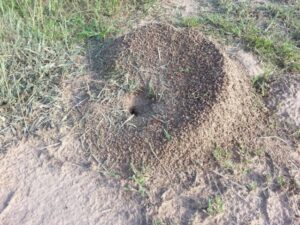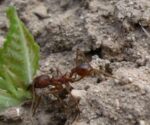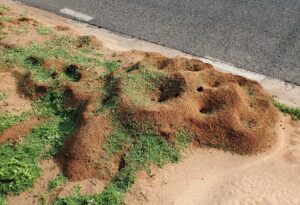 Large Mounds Made by Leafcutting Ants Too
Large Mounds Made by Leafcutting Ants Too
Texas leafcutting ants, Atta texana, are fascinating ants native to Texas, Louisiana, and parts of Mexico. Leafcutting ants create large, extensive colonies, often with multiple mounds clustered in a single area. Mounds are volcano or crater-shaped with a centralized opening and may be mistaken for fire ant mounds, but fire ant mounds do NOT have a centralized opening.
Usually, worker ants of this species, who forage for food, are the most commonly seen leafcutting ants, but in spring it is possible to see reproductive ants, or swarmers. Workers are relatively large ants, reddish-brown in color with three pairs of spines on the thorax and one pair of spines on the back of the head. Workers come in various sizes but can be up to ½ an inch long. Reproductives look similar to worker ants but are much larger in size, with female swarmers being over an inch long. Mated queens have a special area within their mouth to carry fungal spores used to create a fungus garden in the newly founded nest.
Leafcutter Ants Gather for Their Own Garden
 Leafcutting ants typically forage when temperatures are cooler, such as at night or in the morning. They can sometimes cause complete defoliation of plants or small trees overnight. These ants remove leaves and buds from plants in the landscape which they chew and get some nutrition from sap, but mainly place chewed leaves in an underground garden within their colony and use it as a base to grow fungus that they eat. Leafcutting ants tend a particular species of fungus and weed out any other fungus from their garden.
Leafcutting ants typically forage when temperatures are cooler, such as at night or in the morning. They can sometimes cause complete defoliation of plants or small trees overnight. These ants remove leaves and buds from plants in the landscape which they chew and get some nutrition from sap, but mainly place chewed leaves in an underground garden within their colony and use it as a base to grow fungus that they eat. Leafcutting ants tend a particular species of fungus and weed out any other fungus from their garden.
Colonies Can Get Large

Colonies may exist for years and can exceed over two million ants. It is not unusual for a single colony to cover an acre of land. Colonies are usually found in well drained, sandy or loamy soils and are more common in Central to East Texas than other parts of the state.
Unfortunately, leafcutting ants can be difficult to manage, and almost impossible to eradicate completely. Prized plants can be temporarily protected by using spray adhesives around the base of the plant, but adhesives need to be refreshed often when dirt or debris accumulates. Temporary protection can also be provided to prized plants by utilizing contact insecticidal sprays or dusts labeled for “ants”. These insecticidal products can also be used along foraging trails and openings where the ants go into the ground. If mounds are present, Amdro Ant Block, which is the only product labeled for use against leafcutting ants, can be broadcast with a hand-held spreader in the mound area. You do not want to use ant bait and residual dusts and sprays in the same area as pesticidal dusts and sprays can contaminate bait and cause the ants not to pick it up.
When managing leafcutting ants, set expectations at managing, not eradicating. Often when you treat, you’ll knock back a portion of the worker population, but the colony will remain.
For more information or help with identification, contact Wizzie Brown, Texas A&M AgriLife Extension Service Program Specialist.
Additional Resources
About Wizzie

Wizzie Brown
County Extension Program Specialist – Integrated Pest Management
Email:EBrown@ag.tamu.edu
Wizzie has been with Texas A&M AgriLife Extension Service since 2002 and has been playing with insects since she was a toddler. She is an Extension Program Specialist with the Integrated Pest Management (IPM) program. Wizzie holds a B.S. in entomology from The Ohio State University and a M.S. in entomology from Texas A&M University. The integrated pest management program provides identification, biological and management information to whomever needs help. Wizzie’s research focuses on imported fire ants, including community wide fire ant management. Wizzie also is happy to provide programs to area groups on a variety of arthropod-related topics. You can find insect and other arthropod information on Wizzie’s blog.
